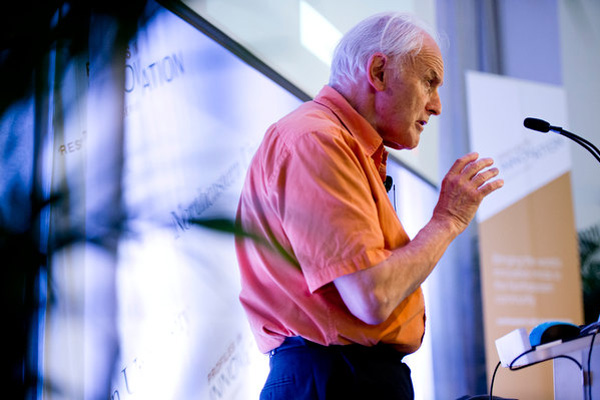A beautiful, peculiar molecule

“Carbon is peculiar,” said Nobel laureate Sir Harold Kroto. “More peculiar than you think.” He was speaking to a standing-room-only audience that filled the Raytheon Amphitheater on Monday afternoon for the latest installment of Northeastern University’s Profiles in Innovation Presidential Speaker Series hosted by Nadine Aubry, dean of the College of Engineering.
Kroto shared the 1996 Nobel Prize in chemistry with his collaborators Richard Smalley and Robert Curl for their discovery of one of the universe’s most peculiar forms of carbon. In the mid-70s Kroto and his colleagues had detected the presence of a long-chain carbon molecule in the giant gas clouds lingering between distant stars using state-of-the-art radio-telescopes.
Wishing to study those molecules more closely, Kroto got in touch with Curl and Smalley, who had developed a method for vaporizing metals and observing the behavior of the resulting particles. “I thought, well, why not change things to graphite and maybe we could produce the carbon chain molecules that we’d detected by radioastronomy,” Kroto said. Essentially, he explained, they’d be recreating the conditions of the Red Giant star, IRC 10216, in which they’d discovered those molecules. Doing so, he posited, should be able to isolate them here on earth.
“It was a simple idea and I knew it would work,” Kroto said. What he didn’t expect was what else he would find along the way.
While the standard carbon species that had been known for decades were present in the analyses that his team produced, one species stood out clearly among the rest. It was a giant peak that the researchers knew to represent a molecule consisting of 60 carbon atoms and nothing else.
At this time the only other forms of known carbon-only molecules were various forms of diamond and graphite. “It’s clearly saying there’s something interesting here,” Kroto said. “And the only thing you really have is structure—it’s got to be something beautiful. The question is what was it.”
During a tense and impassioned 10-day period that followed, the team ultimately landed on a perfectly spherical molecule shaped something like a soccer ball. At each vertex between hexagons and pentagons on the sphere, the researchers conjectured, sat one of 60 carbon atoms. They named the molecule Buckminsterfullerene after the designer of the geodesic dome, which bears the same shape and which helped inspire their revelation about C60.
Now all they had to do was prove their idea. On a Friday five years later, they still had not done so when the journal Nature asked Kroto to review a paper from another research group. It’s title? “Solid C60: A new form of carbon.” It was a beautiful paper, Kroto said, one of the greatest in the whole of chemistry. But it wasn’t his. Should he go to lunch or give up entirely? Those seemed like the only two options until a technician called his lab a few hours later with a spectrum that would seal Kroto’s and his colleagues’ fate.
NMR spectroscopy is an analytical technique that can distinguish between different carbon types in a molecule. “One thing I’d dreamt about,” Kroto said, “was that in C60 all the carbon atoms are equivalent and therefore with one line you should be able to prove its structure.”

Sir Harold Kroto drew a diverse audience of students, faculty, staff, and Boston area community members packing Raytheon amphitheater on Wednesday. Photo by Brooks Canaday.
The competing paper he had on his desk did not have that NMR spectrum. Kroto now did. Six years later he, Curl, and Smalley accepted the Nobel Prize for proving their hunch about one of the universe’s most beautiful molecules.
It has since sparked an entirely new field of chemistry, which has enabled innovations in energy, electronics, and materials science and helped power the nanoscience and nanotechnology revolutions we’ve witnessed in recent years.
The latest event in the Presidential Speaker series—which is designed to bring the world’s most creative minds to campus for conversations on innovation and entrepreneurship—was hosted by the Center for High Rate Nanomanufacturing.
In a Q-and-A following the talk, David Luzzi, engineering professor and executive director of the strategic security initiative at Northeastern, asked Kroto what’s next for carbon-cage molecules and fullerenes. “You have to be able to create whatever cage you want,” Kroto responded. The fullerenes, which also include other spherical molecules of different carbon numbers as well as single-walled carbon nanotubes, have great potential for shifting the paradigm of nanoscience, but without exact control, that shift may never happen, he said.
In response to another question, Kroto noted that none of the major breakthroughs of his career—including the discovery of C60—was funded by a research grant. Instead, he said, existing resources within his institutional department enabled the findings. He called the science research-funding situation in the United States horrific. “It’s totally counterproductive as far as the creative process is concerned,” he said. “You need the freedom of mind to be creative, you can’t be worrying about where the next penny’s coming from.”





